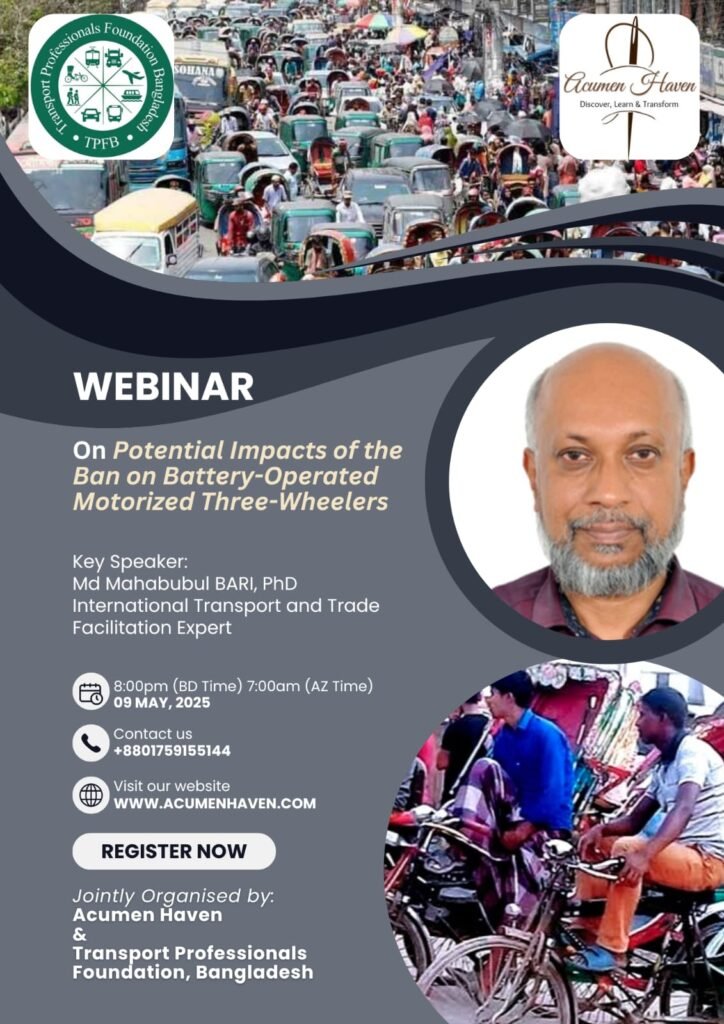Urban transport systems in densely populated cities like Narayanganj, Bangladesh, rely heavily on three-wheelers, which account for 29% of daily trips. These vehicles—primarily battery-operated rickshaws and easy bikes—play a pivotal role in addressing short-distance mobility needs, with 80% of all trips spanning under 4 km. Data reveals that 50% of trips last less than 5 minutes, 70% under 10 minutes, and 80% under 15 minutes, highlighting the dominance of short journeys best served by non-motorized transport (NMT) or compact motorized options. Electric three-wheelers (ETWs) have emerged as a critical solution, bridging gaps in first mile/last-mile connectivity and complementing walking, which constitutes 51% of trips, while buses remain limited to 6.6% of journeys.
Advantages of Electric Three-Wheelers
ETWs offer unmatched accessibility, reaching 94% of Narayanganj’s roads compared to buses, which serve only 7%. Their compact design, affordability, and door-to-door services make them indispensable for essential trips, such as medical visits or goods transport, where walking is impractical. Environmentally, ETWs produce near-zero emissions and have 3–14 times lower lifecycle costs than buses. They also enhance efficiency, reducing passenger wait times by 9.64 minutes on average. By integrating ETWs as formalized feeders to mass transit, cities can optimize urban mobility, curb congestion, and align with sustainability goals.
Challenges and Policy Paradox
Despite their benefits, ETWs face structural and regulatory hurdles. Design flaws—such as inadequate braking systems, poor suspension, and unreliable gears—pose safety risks in crowded areas. Most transport policies in Bangladesh, including a 2024 High Court order, support banning ETWs on major roads due to congestion concerns, potentially disrupting mobility for millions. This policy ignores the absence of alternatives for 80% of short trips and risks exacerbating transport inequality. While pedestrian-friendly infrastructure and NMT networks are ideal long-term solutions, their immediate implementation is unrealistic in cities like Narayanganj. Banning ETWs without substitutes would cripple urban mobility and harm low-income commuters.
A Pathway to Sustainable Integration
To unlock ETWs’ potential, a multi-pronged strategy is essential:
- Vehicle Upgrades: Mandate dual braking systems, enhanced suspension, and standardized safety features to address design limitations.
- Policy Reforms: Introduce licensing frameworks, designated operational zones, and regular inspections to ensure compliance with safety and performance standards.
- Infrastructure Development: Establish solar-powered charging stations with battery-swap technology, maintenance depots at transport hubs, and smart parking systems to support scalability.
- System Integration: Formalize ETWs as feeder services, integrate fares with mass transit, and optimize routes using real-time data to reduce redundancies.
Conclusion
Electric three-wheelers are not merely stopgap solutions but foundational to sustainable urban mobility in Bangladesh. Their economic viability, environmental benefits, and adaptability to narrow roads make them irreplaceable in cities like Narayanganj. By adopting targeted reforms, policymakers can transform ETWs into a regulated, efficient component of the transport network, mitigating congestion rather than exacerbating it. Narayanganj’s experience offers a blueprint for South Asian cities grappling with similar challenges, proving that inclusive planning and innovation can turn informal transport into a pillar of sustainable development. Banning ETWs without alternatives is unsustainable; instead, integrating them intelligently is the key to equitable, green urban futures.



